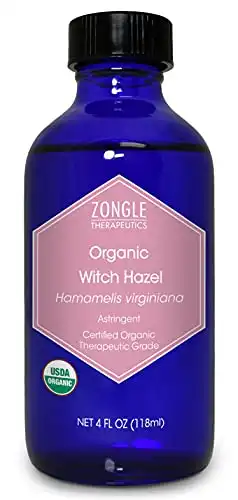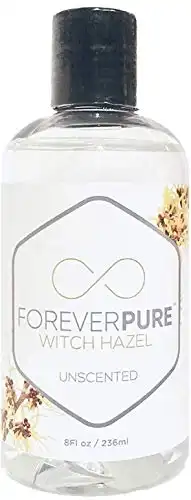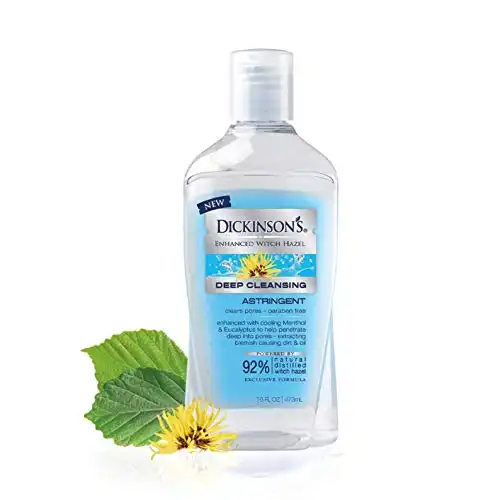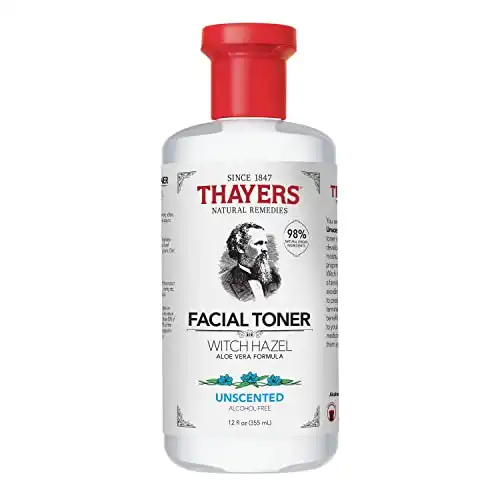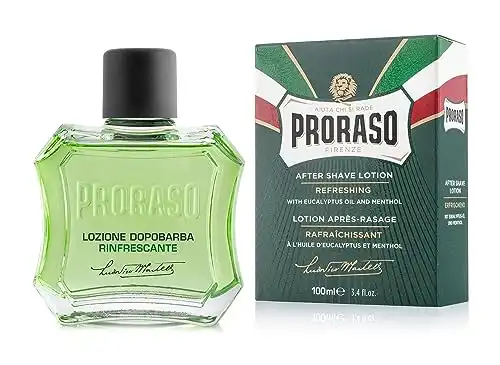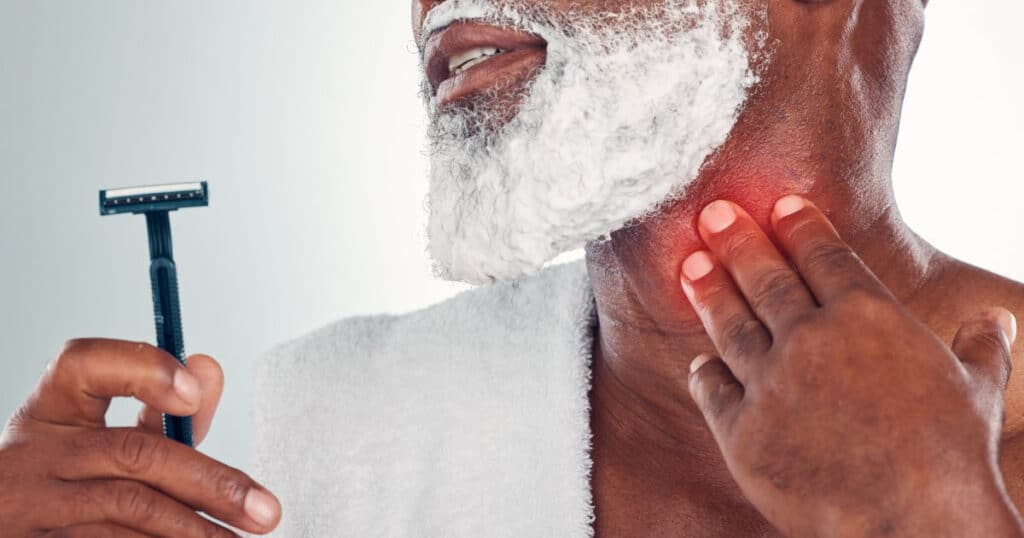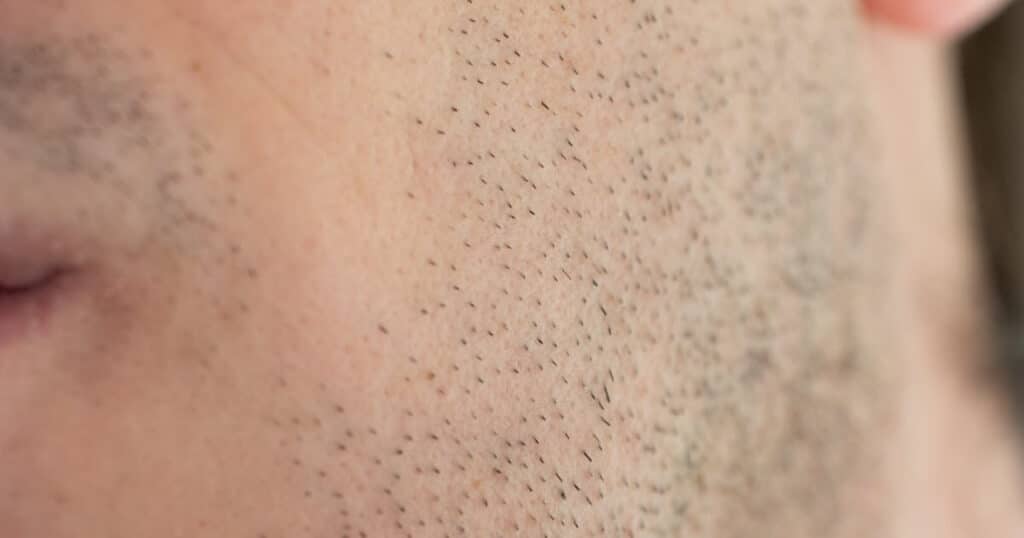Witch hazel is a funky name for a natural ingredient that you may have already heard about if you’re an avid wet shaver. Using witch hazel after shaving is an old-school practice, and even after more than a hundred years, it hasn’t gone out of fashion. In fact, it’s become a lot more popular in recent years, and there are a LOT of posts on various shaving boards about it.

So why is witch hazel such a popular aftershave alternative? Should you add it to your post-shaving routine? If you do… which witch hazel product should you buy?
In this post, we’ll explain what witch hazel is, its benefits when it comes to shaving, how to use it, and, finally, we’ll let you know about our favorite witch hazel products. Let’s start at the start:
What is Witch Hazel?
Witch hazel is the common name for the plant Hamamelis virginiana. The plant itself is a small, flowering shrub that’s native to North America. Uniquely, its spindly yellow flowers bloom in winter! You can see what they look like in the image below:
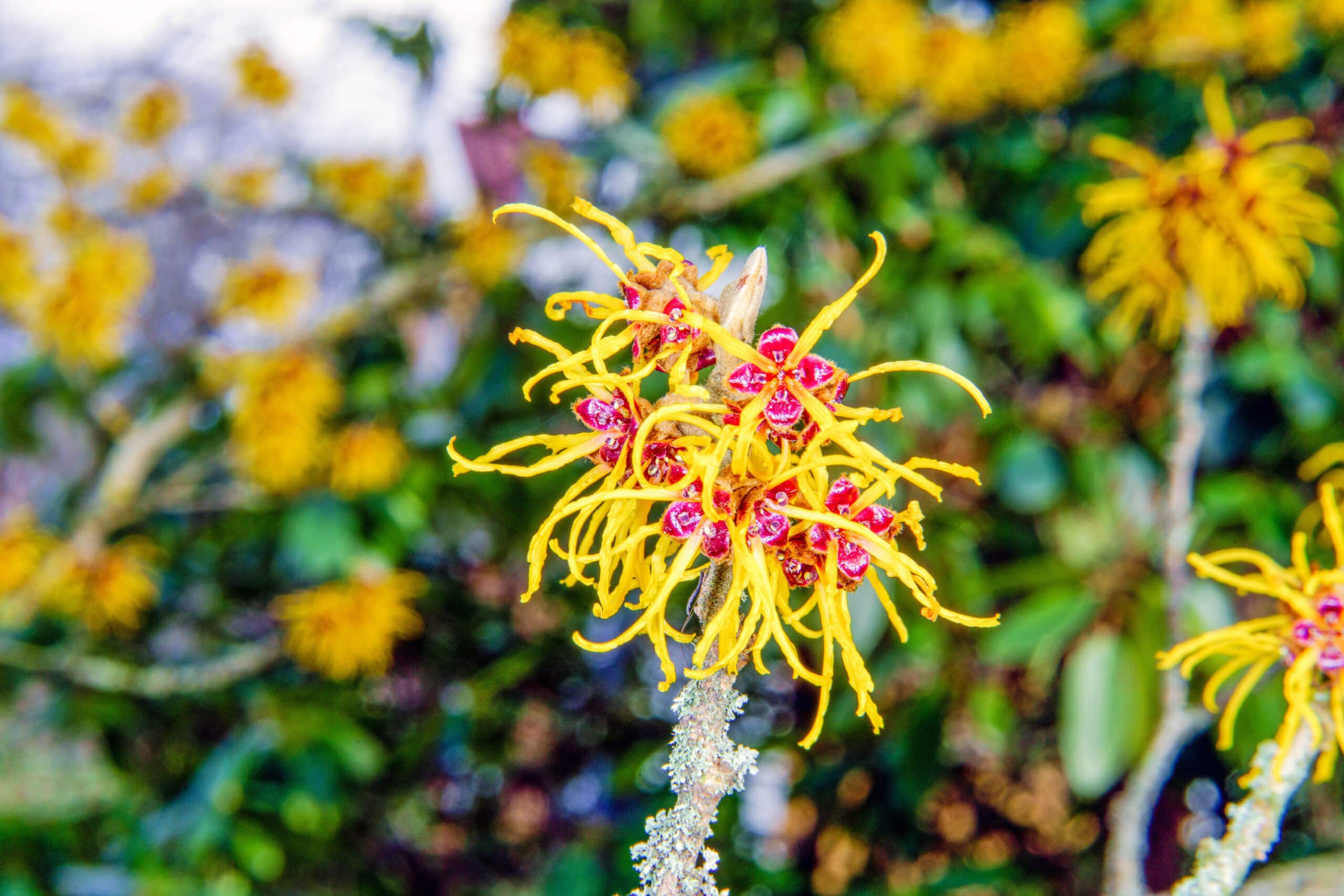
In the context of grooming, what you’ll usually find in stores is a witch hazel extract, which doesn’t come from the flowers but from the bark, leaves, and twigs of the shrub.
Witch hazel has a long history in Native American medicine, especially as a remedy for wounds, insect bites, and burns. We don’t know exactly when men started using witch hazel after shaving, but thanks to this shaving guide from 1905, we can tell that it has been a popular remedy for over a century.
Nowadays, this extract is a popular skin treatment, and it’s even classified as an over-the-counter drug by the FDA.
How Are Witch Hazel Products Made? What’s In Them?
There are a few different kinds of witch hazel products that you may find in stores. Almost all of them are made by heating or soaking witch hazel bark and twigs to extract their most beneficial components.

The most common is an alcohol extraction, which leads to a liquid that’s incredibly rich in potent witch hazel constituents. The plant can also be steam-distilled, which leads to a water-based witch hazel extract that isn’t quite as potent but is also free from drying alcohol.
No matter what kind of witch hazel you end up with, all of them generally contain the same constituents, albeit at slightly different concentrations. Those constituents are tannins, flavonoids, and fragrance compounds.
Finally, many brands combine witch hazel extract with other beneficial ingredients, to make brand new products! You can find witch hazel in aftershaves, toners, lotions, balms, and more.
Benefits of Using Witch Hazel As Aftershave
So what’s the big deal? Here are the unique benefits that witch hazel is known for:

Witch Hazel is an Astringent. Witch hazel is rich in molecules called tannins, which make it a strong astringent. If you’re not familiar, an astringent is anything that constricts body tissue, and in the case of topical application, it constricts the proteins in the skin. Just imagine that tight feeling you get in your mouth after drinking a particularly dry wine or a strong tea.
Using an astringent after shaving can temporarily tighten your pores which may prevent post-shave blemishes and razor bumps. It mimics the tight feel you get from using alcohol, although mildly, and helps the skin feel cleaner. It may also help to stop the bleeding from very tiny nicks or cuts (although for larger ones, you’ll want to use an alum block or styptic pencil).
Witch Hazel is Soothing. Witch hazel is one of the very few natural ingredients classified by the FDA as a non-prescription drug. According to the FDA, it can be used topically to relieve minor irritation. We think this is it’s greatest benefit as a post-shave remedy.
The combination of tannins and antioxidant flavonoids in witch hazel makes it a soothing natural ingredient. One study showed that it could alleviate signs of sunburn irritation, while another showed that it could help mitigate some of the symptoms of eczema.
These anti-inflammatory capabilities suggest that witch hazel could also help with other forms of irritation! You could try witch hazel for razor burn prevention as well as for just generally soothing the skin.
Witch Hazel Balances pH. Most shaving soaps and creams are alkaline, but human skin needs to be slightly acidic to thrive and repel bacteria. Witch hazel, which has an acidic pH, may help balance the skin and restore its acidity after shaving.
Witch Hazel Kills Some Bacteria. Amazingly, witch hazel has some antibacterial capabilities. It has only been tested against a few types of bacteria, but one of them is Staphylococcus aureus, which is the main bacteria that causes folliculitis (i.e. the scientific name for razor bumps). In other words, this means that witch hazel could help prevent those razor bumps that are caused by bacteria.
Witch Hazel is All-Natural. If you’re sick of unpronounceable synthetic ingredients or you struggle with sensitivities from commercial products, you may appreciate that witch hazel is a simple, all-natural ingredient. Just keep in mind that some products marketed as witch hazel are blended with other ingredients, so always check the label to see what you’re getting.
Witch Hazel is Usually Affordable. Because witch hazel grows abundantly and is easy to distill, it’s quite affordable! You generally won’t have to shell out too much money for a large bottle of the stuff.

How to Use Witch Hazel After Shaving
So are you keen to trade in your typical aftershave for some witch hazel? If so, the good news is that using it isn’t too different from using your regular aftershave. You can splash it on after every shave, to help soothe and tighten your skin.
After you’ve shaved and rinsed away all of the lather, pour a small amount of witch hazel into the palm of your hand. Then, rub both hands together carefully, and press the witch hazel into your skin with your palms, much as you would an aftershave splash.
Be careful not to rub the witch hazel into your skin. Instead, opt for more of a tapping motion, which is gentler and less likely to irritate your skin. Alternatively, you can also put your witch hazel liquid in a spray bottle, so you can mist it on your face directly without having to use your hands.
Once you’re done, there’s no need to rinse! You can end things here, or follow it up with an aftershave balm to give the skin added moisture.
Witch Hazel Myths and Safety
As much as we love witch hazel, we don’t care for misinformation. There are a few misunderstandings when it comes to witch hazel, so here’s our balanced explanation.
Is Witch Hazel Irritating? This question comes up often in skincare science circles. A lot of big voices in the industry believe that it is very irritating because it contains some fragrance compounds—namely, eugenol—while others say that the issue is alcohol distillation.
In reality, however, alcohol at such a low concentration probably isn’t a big deal. This blog post, written by two chemists, explains the topic pretty well. By looking at studies that show that alcohol-based hand sanitizers with much higher concentrations of alcohol didn’t irritate the skin, we can surmise that at 14%, alcohol-extracted witch hazel probably won’t cause issues either, aside from perhaps some slight, easily-fixed dehydration.
Second, there’s a concern that trace amounts of fragrance in witch hazel can be irritating. If your skin is extremely sensitive to scented products, you may want to avoid witch hazel as well as many other natural extracts. However, the reality is that this is only an issue for a small percentage of the population.
So if you’re allergic to witch hazel, don’t use it! You can find out if you might be allergic to it by testing it on a small patch of skin. Just dab a little on your forearm or behind your ear, leave it alone for a few hours, and check back to see if there’s any irritation.
Is Witch Hazel Too Drying? Witch hazel’s astringency and potential alcohol content mean that it can be somewhat drying to the skin, but it’s not nearly as drying as a shaving soap or a traditional aftershave. Additionally, whether that tightening, drying effect is a bad or good thing really depends on you.
We’re big believers in keeping the skin strong and moisturized after shaving, usually with the help of an aftershave balm, but we gotta admit that we also enjoy that tightening that comes with a nice, bracing aftershave. While the benefits of that tightening, drying effect are minor and only relevant in the short term, what’s clear is that they’re better in the form of witch hazel, which also happens to be soothing.
Is Witch Hazel a Disinfectant? As we mentioned earlier, witch hazel has some antibacterial properties. However, this doesn’t make it a disinfectant! In researching this article, we came across many claims that witch hazel can act as an antiseptic.
Especially nowadays, it’s really important to stress that just because an ingredient has some antiseptic effects doesn’t make it a broad-spectrum disinfectant. Using witch hazel as an aftershave may help prevent some of the ill effects of certain bacteria (and especially ones that are more likely to cause issues post-shaving), but please don’t reach for it instead of hand sanitizer or when you need to do proper first aid.
Our Favorite Witch Hazels To Use After Shaving
Are you interested in adding witch hazel to your shaving routine? If so, here are some witch hazel products we think you might like.
"It’s not likely to irritate your skin unless you’re quite sensitive. It’ll feel a little more like a traditional aftershave than some other options, and the higher amount of tannins will have a more potent astringent effect."
- RTG Editorial
This simple, pure, and organic witch hazel is our top choice. It’s certified as organic by the USDA, so we know the plant itself was farmed without pesticides. You can use this witch hazel as an aftershave on its own, or mix it into a DIY aftershave concoction.
It’s an alcohol-based distillate, which means that there’s around 14% grain alcohol in the blend while the remainder of it is the witch hazel extract. As we already touched on, alcohol distillation leads to a witch hazel extract that’s very rich in tannins and other antioxidant polyphenols.
At such a small percentage, it’s not likely to irritate your skin unless you’re quite sensitive. It’ll feel a little more like a traditional aftershave, and the higher amount of tannins will have a more potent astringent effect.
However, if you have dry skin and would prefer an alcohol-free witch hazel, check out our next pick.
"If your skin doesn’t tolerate alcohol, then this formula can help soothe and tighten your skin gently after a shave. The only drawback to this witch hazel is the smell. This extract is unscented, so the pure, woodsy witch hazel smell can be a little unpleasant to some."
- RTG Editorial
This pure witch hazel is steam-distilled, which means that the witch hazel bark and twigs are boiled. As the water boils and evaporates, its steam ends up infused with many of the bioactive compounds that make witch hazel so beneficial. However, the water-based liquid isn’t as potent as an alcohol extraction.
If your skin doesn’t tolerate alcohol, then this formula can help soothe and tighten your skin gently after a shave. The only drawback to this witch hazel is the smell. This extract is unscented, so the pure, woodsy witch hazel smell can be a little unpleasant to some.
"What makes this witch hazel astringent stand out to us is that it also contains menthol and eucalyptus. If you want to use witch hazel as an aftershave, the scent will remind you of a traditional aftershave."
- RTG Editorial
Dickinson’s is one of the oldest witch hazel companies around, and they have a range of witch hazel-infused products, including their Original toner which is a perfectly serviceable—albeit non-organic—alcohol-based witch hazel extract. It was hard to pick, but we ultimately decided to include their deep cleansing toner on our list.
What makes this witch hazel astringent stand out to us is that it also contains menthol and eucalyptus. If you want to use witch hazel as an aftershave, the scent will remind you of a traditional aftershave. The menthol makes this witch hazel bracing and cooling, while the eucalyptus masks any odd smells and adds a masculine woodiness.
For those with sensitive skin, these fragrances will be an issue, but if you’re switching to witch hazel from a traditional aftershave splash, this will likely give you a more familiar experience.
Thayer’s is another one of the original brands that helped popularize witch hazel. However, many buyers don’t realize that Thayer’s doesn’t sell pure witch hazel. Thayer’s toners and astringents are all made with witch hazel grown on the company’s Connecticut farm, but then other ingredients are added, like hydrators and preservatives.
That’s not necessarily a bad thing, though! If you want a pure witch hazel extract, you’ll need to buy from a different brand. If you’d like a gentle, hydrating toner that also includes witch hazel, then this is it.
Thayer’s alcohol-free Witch Hazel Toner includes hydrating ingredients like aloe vera and glycerin, which can be useful if you have dry skin. It’s not as astringent as the pure extract, but it’s more gentle. You can use it as an aftershave, but you may also like it all over your face as a soothing daily toner.
"It’s a nice choice if you want to use a real aftershave with alcohol and a great smell, but you also want to benefit from the soothing effects of witch hazel."
- RTG Editorial
This isn’t a pure witch hazel, but a popular aftershave that’s boosted by a healthy amount of the wonderful plant extract. It comes from Proraso, which is one of the world’s biggest traditional shaving product companies.
It’s a nice choice if you want to use a real aftershave with alcohol and a great smell, but you also want to benefit from the soothing effects of witch hazel. This aftershave also contains a small amount of glycerin, which helps to mitigate some of the alcohol’s drying effects.
Bottom Line on Using Witch Hazel After Shaving
If you’ve been looking for a new aftershave splash, we hope our post turned you on to a great natural alternative – using witch hazel after shaving!
We’re not surprised that so many aftershave brands add it to their products.
This is our bottom line on this unique ingredient: When it comes to the skin’s wellbeing, witch hazel is gentler and more soothing than average aftershave liquid, even if it doesn’t smell quite as good.
Whatever you choose, have fun, be good, and happy shaving!
Michael Morris is the head writer here at Rough and Tumble Gentleman. He's got a ducktail beard and loves Brazilian jiu-jitsu. He's married to the woman of his dreams and lives in Brooklyn, NY.


